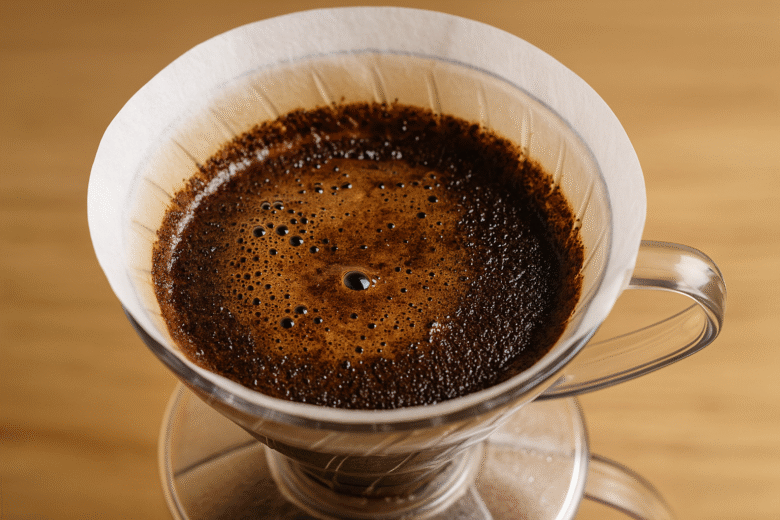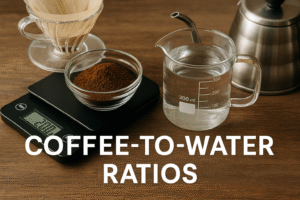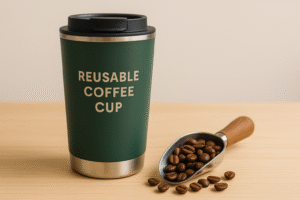If you’ve ever poured hot water over freshly ground coffee and seen it puff up, bubble, or swell, you’ve witnessed the coffee bloom. For some, it’s just an interesting moment in the brewing process. For others, it’s a critical step that separates a good cup of coffee from a truly great one.
But what exactly is the bloom? Why does it happen? And how can mastering it improve the taste and balance of your brew?
In this comprehensive guide, you’ll learn the science behind coffee bloom, how to bloom your coffee properly using different methods, and why skipping this simple step might be sabotaging your morning cup.
What Is Coffee Bloom?
The coffee bloom is the visible release of gas—primarily carbon dioxide (CO₂)—from the coffee grounds when they come into contact with hot water.
During roasting, coffee beans accumulate CO₂. When you grind those beans, the surface area increases, allowing that trapped gas to escape rapidly when hot water is added.
This bubbling or “blooming” reaction is particularly strong with freshly roasted coffee. Older coffee has already degassed, so you may see less bloom.
Why Does Blooming Matter?
The coffee bloom affects both extraction and flavor. Here’s why:
- Removes trapped CO₂: Gas blocks water from fully saturating the grounds. If not released, CO₂ can lead to uneven extraction.
- Improves flavor balance: Proper blooming leads to better saturation, resulting in more sweetness and clarity in your coffee.
- Reveals freshness: A strong bloom is a good sign that your coffee beans are fresh and well-roasted.
Skipping the bloom often leads to sour, under-extracted coffee, especially in manual brewing methods like pour-over or French press.
How to Bloom Coffee Properly
The process of blooming is simple, but it varies slightly depending on the brewing method. In general, you’ll:
- Add a small amount of hot water to the grounds (about double the weight of the coffee).
- Wait 30 to 45 seconds to allow gas to escape.
- Continue pouring or steeping as normal.
The key is to ensure all the grounds are saturated during the bloom phase.
Blooming by Method
1. Pour-Over (V60, Kalita, Chemex)
- Grind Size: Medium-fine
- Water Temp: 92–96°C (195–205°F)
- Bloom Water: 2x coffee dose (e.g., 20g coffee → 40g water)
- Bloom Time: 30–45 seconds
- Tip: Pour in circles and avoid dry pockets. Use a gooseneck kettle for precision.
2. French Press
- Grind Size: Coarse
- Add just enough water to cover the grounds
- Stir gently, wait 30 seconds, then add remaining water
- Tip: Blooming helps reduce gas bubbles that interfere with plunging later
3. AeroPress
- Grind Size: Medium-fine to fine
- Use 20g coffee → 40g bloom water
- Stir vigorously and wait 30 seconds before pressing
- Tip: Use the inverted method to give yourself more control
4. Espresso
Espresso doesn’t involve a visible bloom, but pre-infusion serves a similar function—wetting the grounds under low pressure before full extraction.
- Machines with pre-infusion settings release water gently for 2–4 seconds
- Helps avoid channeling and enhances balance in the shot
5. Drip Coffee Makers
Most basic machines skip blooming altogether, which can lead to flat flavor.
Higher-end brewers like Technivorm Moccamaster or Breville Precision Brewer simulate blooming by pulsing water early in the cycle.
How to Know If You’re Blooming Correctly
Signs of a good bloom:
- The grounds swell or dome up slightly
- Visible bubbles rise and pop
- The bed appears evenly saturated afterward
If your coffee just sits flat and does nothing, it may be:
- Too old
- Too coarse
- Too cool (water below 90°C)
- Not enough water used during bloom
Common Blooming Mistakes
1. Skipping the bloom: Leads to under-extracted, sour, or inconsistent cups.
2. Not using enough water: Incomplete saturation leaves dry pockets and uneven flavor.
3. Pouring too aggressively: Disturbs the grounds too early and may lead to channeling in pour-over.
4. Blooming with stale beans: You’ll see minimal bubbling—and poor taste, regardless of your technique.
5. Not stirring or swirling (when needed): Helps saturate all grounds, especially in methods like French press and AeroPress.
Does Blooming Always Improve the Coffee?
In most manual methods: yes. It ensures even wetting, avoids channeling, and allows proper extraction.
However, some pre-ground, supermarket coffees (especially older ones) may not need blooming. They’ve already released most of their gas.
Still, blooming rarely hurts—and in many cases, it elevates your cup from “decent” to “excellent.”
Blooming and Coffee Freshness: What You Can Learn
One of the most useful things about blooming is that it acts as a freshness test. If your coffee blooms aggressively, it’s likely fresh.
If there’s little to no bloom:
- The beans may be weeks or months past roast
- The coffee may have been ground long ago
- Exposure to air and moisture has reduced CO₂ content
Even well-stored beans start to lose bloom intensity after 2–3 weeks post-roast.
Advanced Bloom Techniques
1. Stirring Bloom Phase
In pour-over or AeroPress, stirring the slurry gently during bloom can:
- Help break up clumps
- Improve overall saturation
- Enhance balance
Use a spoon, bamboo stick, or swirl the dripper lightly.
2. Pulse Blooming (Double Bloom)
Some baristas use two short bloom phases, especially with light roasts:
- Add 1x water weight, wait 30 seconds
- Add another equal dose, wait 10 seconds
- Continue brew
This method increases control and reduces channeling risk.
How Bloom Time Affects Flavor
- Short bloom (15–20 sec): Might under-degas, especially with fresh beans
- Standard bloom (30–45 sec): Balanced extraction, suitable for most beans
- Long bloom (60+ sec): Useful for very fresh or light-roasted coffees
Too long, and the grounds may start to cool down, affecting extraction negatively.
Frequently Asked Questions (FAQs)
1. Do dark and light roasts bloom differently?
Yes. Light roasts usually retain more gas and bloom more actively. Dark roasts may degas faster post-roast.
2. Is blooming necessary for pre-ground coffee?
Not always, but it can’t hurt. Even pre-ground coffee may release some trapped gas if relatively fresh.
3. What if my coffee doesn’t bloom at all?
Likely too old or stale. Try fresher beans, a finer grind, or hotter water.
4. Can blooming change coffee acidity?
Indirectly, yes. Better extraction through blooming helps balance acidity with sweetness and body.
5. Can I skip blooming with a drip machine?
Most basic drip machines don’t allow it. Use a machine with pre-infusion, or try manual methods instead.
6. What’s the best water-to-coffee ratio for blooming?
Generally, 2:1 (40g water for 20g coffee). Adjust as needed based on roast and grind.
7. Does water quality affect bloom?
Absolutely. Fresh, filtered water at the correct temperature enhances bloom effectiveness.
Final Thoughts – Small Step, Big Difference
The coffee bloom might only last 30 to 45 seconds, but it has a major impact on your final cup. Skipping it is like skipping the warm-up in a workout—technically optional, but practically essential.
Once you understand what’s happening, blooming becomes more than a step. It becomes part of the ritual—the quiet moment where the coffee comes alive.
Whether you’re brewing a delicate Ethiopian pour-over or a bold French press, take the time to bloom. You’ll taste the difference.

Marcio Luzardo is a coffee enthusiast and the voice behind Tudo Viraliza. With a passion for turning curiosity into practical knowledge, he shares easy-to-follow tips, guides, and insights to help readers enjoy better coffee every day. When he’s not writing, Marcio is exploring new brewing methods or diving into the rich stories that connect coffee to culture, lifestyle, and wellness.



